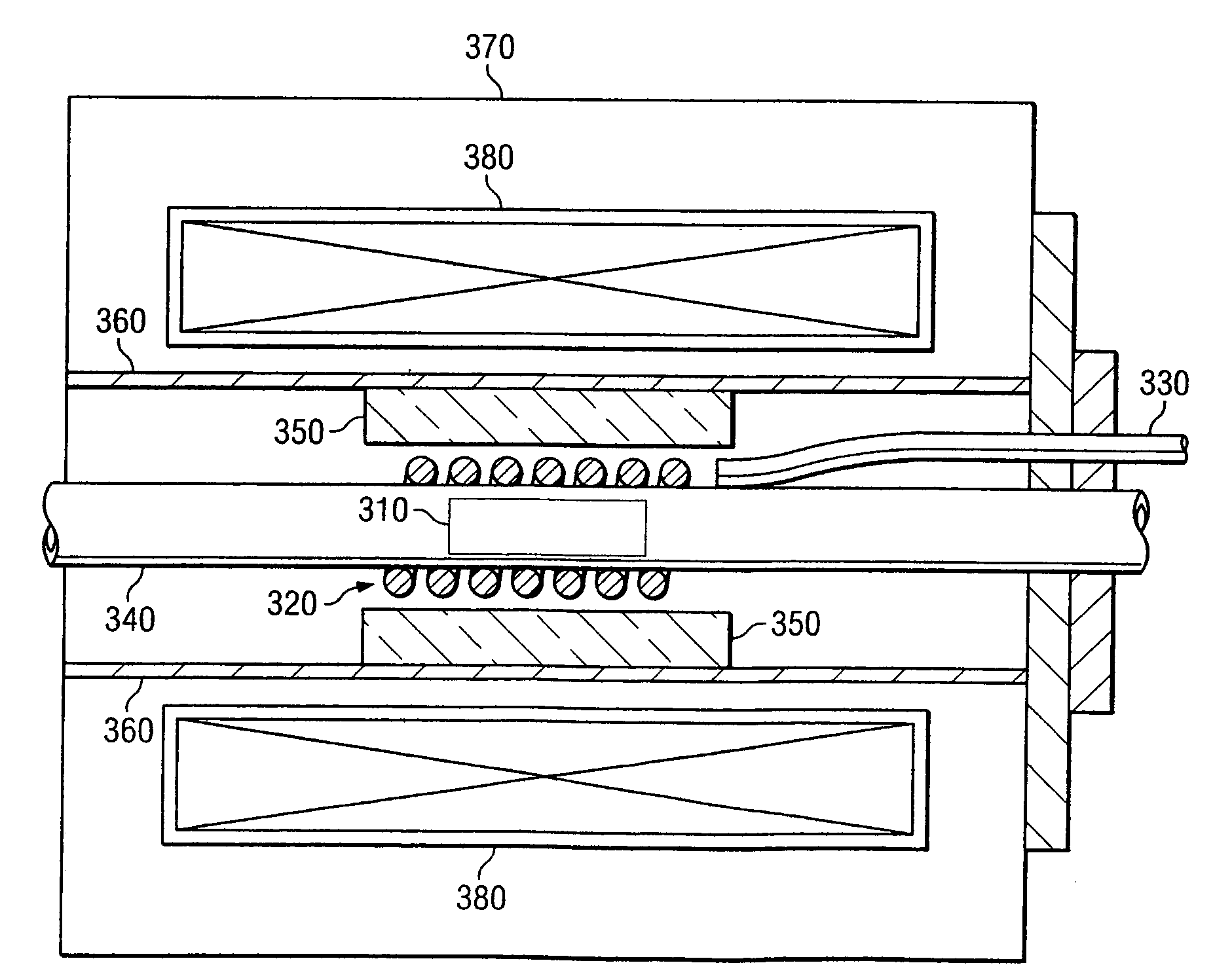High magnetic field ohmically decoupled non-contact technology
a magnetic field and non-contact technology, applied in the direction of electric/magnetic/electromagnetic heating, induction heating, electrical equipment, etc., can solve the problems of limited temperature range of ultrasonic transducers, unsatisfactory chemical interactions, and limit the energy transfer
- Summary
- Abstract
- Description
- Claims
- Application Information
AI Technical Summary
Benefits of technology
Problems solved by technology
Method used
Image
Examples
example 1
[0045]An embodiment of a non-contact, ultrasonic, ohmically decoupled insert inside a nine Tesla superconducting magnet is shown in FIG. 3. The work piece 310 is shown inside a single induction coil 320. The coil 320 includes a single layer of water-cooled copper tubing. Power is fed to the coil by way of a coaxial transmission line 330. The work piece 310 is electrically and thermally insulated from the induction coil 320 by a quartz tube 340. Ceramic spacers 350 support the induction coil against electromagnetic forces. An actively cooled conductive lining 360 is placed between the induction coil and the bore of the cryostat to prevent heat loading of the cryogenic system 370 of the superconducting magnet 380. Some electromagnetic energy is deposited in the lining. This particular embodiment includes a superconducting magnet including of niobium-titanium conductors that are readily commercially supplied by American Magnetics, Inc.
example 2
[0046]An embodiment for continuous work piece processing is shown in FIG. 4. A continuous work piece 410 passes coaxially through a super conducting solenoid magnet assembly 420. This embodiment also illustrates a dual coil configuration. One coil 450 is optimized for inductive heating of the work piece. The other coil 460 is optimized for application of ultrasonic excitation. Thermal insulation 430 is used to minimize the heat load on the superconducting magnet's cryostat 470. There are spaces 425 for cooling gases between the work piece 410 and the thermal insulation 430 and also between the thermal insulation 430 and a conductive electromagnetic barrier 440.
example 3
[0047]An embodiment is shown in FIG. 5 that heats a work piece 510 by a heated gas from a hot gas work piece heating system 520 via a gas distribution nozzle 530 while ultrasonic energy is applied through an induction coil 540 that is water or gas cooled. This embodiment illustrates another method of separating heating and ultrasonic processing functions. Thermal insulation 580 is used to minimize the heat load on the magnet 590. There are spaces 560 for cooling gases between the work piece 510 and the thermal insulation 580 and also between the thermal insulation 580 and a conductive electromagnetic barrier 570.
PUM
 Login to View More
Login to View More Abstract
Description
Claims
Application Information
 Login to View More
Login to View More - R&D
- Intellectual Property
- Life Sciences
- Materials
- Tech Scout
- Unparalleled Data Quality
- Higher Quality Content
- 60% Fewer Hallucinations
Browse by: Latest US Patents, China's latest patents, Technical Efficacy Thesaurus, Application Domain, Technology Topic, Popular Technical Reports.
© 2025 PatSnap. All rights reserved.Legal|Privacy policy|Modern Slavery Act Transparency Statement|Sitemap|About US| Contact US: help@patsnap.com



